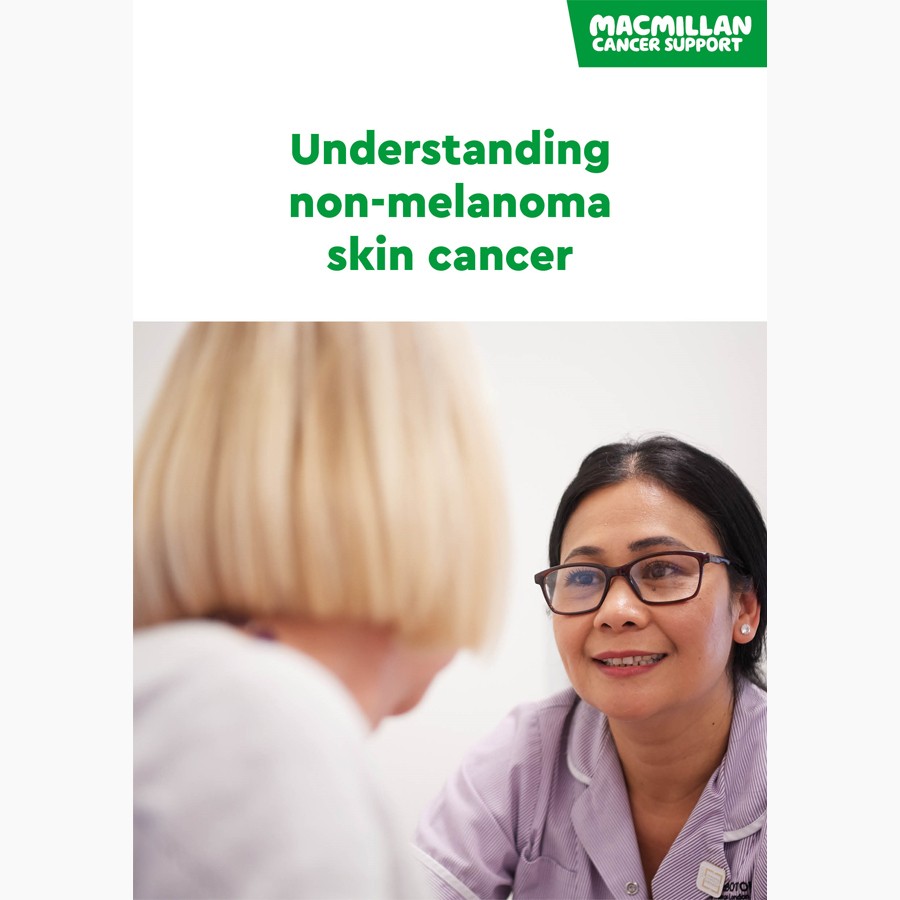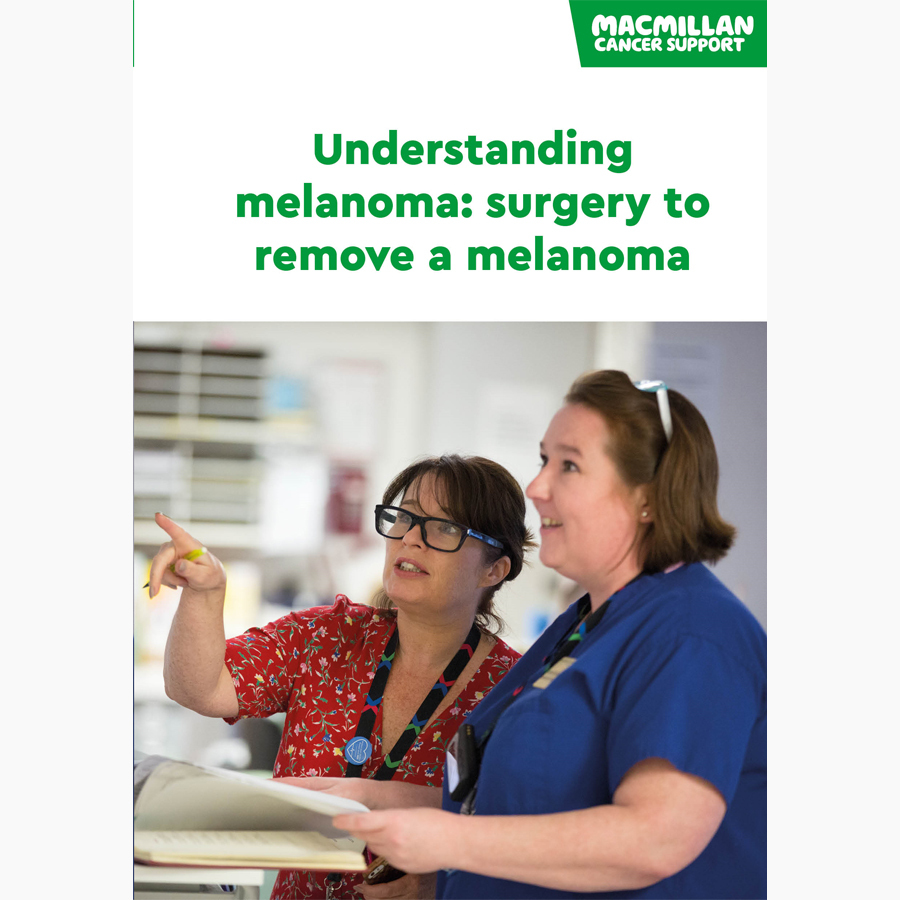Types of skin cancer
On this page
What are the different types of skin cancer?
Skin cancers can be split into 2 groups:
- non-melanoma, including basal cell carcinoma (BCC) and squamous cell carcinoma (SCC)
- melanoma, including melanoma, lentigo maligna melanoma, superficial spreading melanoma.
You can find out more about non-melanoma skin cancers and how they are treated in our skin cancer information.
Melanoma is treated differently from non-melanoma skin cancers. We have separate information about melanoma.
You can visit our Online Community skin cancer forum to talk with people who have been affected by skin cancer, share your experience, and ask an expert your questions.
Related pages
What do different types of skin cancer look like?
Skin cancers can vary in how they look. They can also look different on different skin types. For example, some skin cancer symptoms may be less obvious on black or brown skin.
Even for an expert, it is not always possible to tell whether skin changes are cancer just by looking at the skin. There are many other skin conditions that are not cancer.
If you are worried about skin changes, we have more information about possible skin cancer symptoms. This includes descriptions of some features of the most common types of skin cancer and possible symptoms of melanoma.
If you are searching for pictures or photos of skin cancers or skin conditions, the British Skin Foundation has an A-Z of skin.
Related pages
Booklets and resources
What is basal cell carcinoma (BCC)?
Basal cell carcinoma (BCC) is the most common type of skin cancer in the UK. It starts in the basal cells in a layer of the skin called the epidermis. BCCs sometimes used to be called rodent ulcers.
Most BCCs are very slow-growing, low-risk skin cancers. They almost never spread to other parts of the body. Nearly everyone who has treatment for a BCC is completely cured.
A few BCCs may come back in the same area of skin after treatment. This is known as a local recurrence.
Occasionally, BCCs grow more quickly. If left to grow, they may spread into the deeper layers of the skin or areas under the skin. Very rarely, BCC can spread to the bones.
What is squamous cell carcinoma (SCC) of the skin?
Squamous cell carcinoma (SCC) of the skin is sometimes called cutaneous squamous cell carcinoma. It is the second most common type of skin cancer in the UK. It develops from the squamous cell layers of the skin.
Most people treated for SCC of the skin are completely cured. But if left untreated for a long time, SCC may spread to other parts of the body, such as the lymph nodes. Sometimes SCC can grow and spread quickly. But this is not common.
What is melanoma?
Melanoma develops from cells in the skin called melanocytes. It is a less common type of skin cancer. Melanoma is treated differently from non-melanoma skin cancers.
Rarer types of skin cancer
There are some other types of cancer that can affect the skin:
- Merkel cell carcinoma
- Kaposi’s sarcoma
- cutaneous T-cell lymphoma of the skin
- sarcoma.
These are much less common than BCC and SCC. They are treated differently.
What is Bowen's disease?
Bowen’s disease is a growth of abnormal cells in the outer layer of the skin (epidermis). It is also called squamous cell carcinoma in situ. It is sometimes called a pre-cancerous condition. If it is not treated, it can sometimes develop into squamous cell carcinoma (SCC).
Bowen’s disease is not a serious condition and there are many effective treatments. The abnormal cells grow very slowly and are unlikely to cause a problem in most people.
About our information
-
References
Below is a sample of the sources used in our skin cancer information. If you would like more information about the sources we use, please contact us at informationproductionteam@macmillan.org.uk
Keohane SG, Botting J, Budny PG, et al. British Association of Dermatologists guidelines for the management of people with cutaneous squamous cell carcinoma 2020. The British Journal of Dermatology. 2021;184(3): 401–414. Available from www.doi.org/10.1111/bjd.19621 [accessed May 2024].
Nasr I, McGrath EJ, Harwood CA, et al. British Association of Dermatologists guidelines for the management of adults with basal cell carcinoma 2021. The British Journal of Dermatology. 2021;185(5): 899–920. Available from www.doi.org/10.1111/bjd.20524 [accessed May 2024].
Sharma A, Birnie AJ, Bordea C, et al. British Association of Dermatologists guidelines for the management of people with cutaneous squamous cell carcinoma in situ (Bowen disease) 2022. The British Journal of Dermatology. 2023;188(2): 186–194. Available from: www.doi.org/10.1093/bjd/ljac042 [accessed May 2024].
-
Reviewers
This information has been written, revised and edited by Macmillan Cancer Support’s Cancer Information Development team. It has been reviewed by expert medical and health professionals and people living with cancer. It has been approved by Senior Medical Editor, Professor Samra Turajlic, Consultant Medical Oncologist.
With thanks to: Dr Stephanie Arnold, Consultant; Kerry Jane Bate, Advanced Nurse Practitioner; Dr Philippa Closier, Clinical Oncologist; Sharon Cowell-Smith, Macmillan Advanced Nurse Practitioner Skin Cancers; and Dr Benjamin Shum, Medical Oncologist.
Thanks also to the other professionals and people affected by cancer who reviewed this edition, and to those who shared their stories.
Our cancer information has been awarded the PIF TICK. Created by the Patient Information Forum, this quality mark shows we meet PIF’s 10 criteria for trustworthy health information.
The language we use
We want everyone affected by cancer to feel our information is written for them.
We want our information to be as clear as possible. To do this, we try to:
- use plain English
- explain medical words
- use short sentences
- use illustrations to explain text
- structure the information clearly
- make sure important points are clear.
We use gender-inclusive language and talk to our readers as ‘you’ so that everyone feels included. Where clinically necessary we use the terms ‘men’ and ‘women’ or ‘male’ and ‘female’. For example, we do so when talking about parts of the body or mentioning statistics or research about who is affected.
You can read more about how we produce our information here.
Date reviewed

Our cancer information meets the PIF TICK quality mark.
This means it is easy to use, up-to-date and based on the latest evidence. Learn more about how we produce our information.
How we can help





